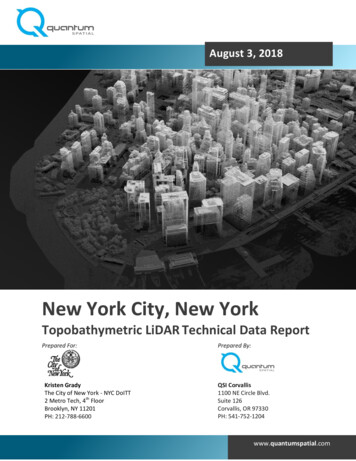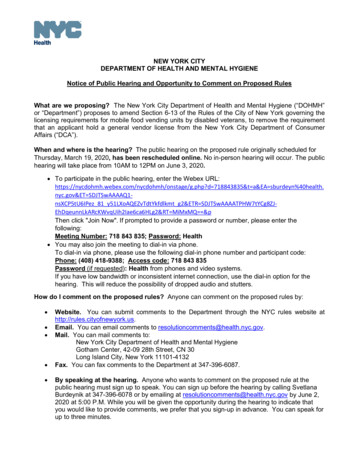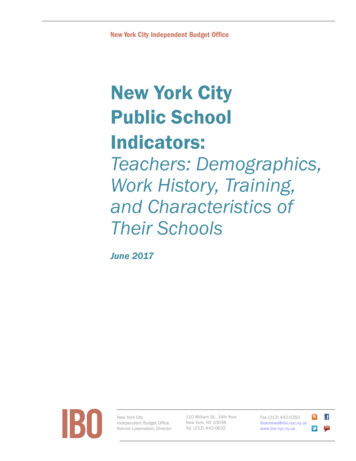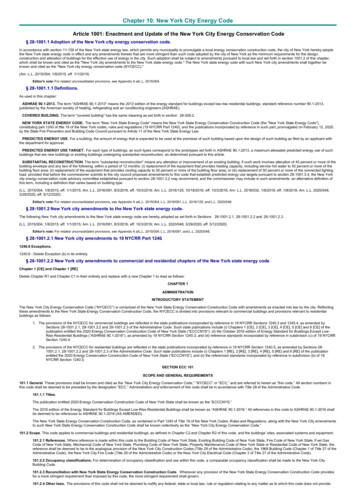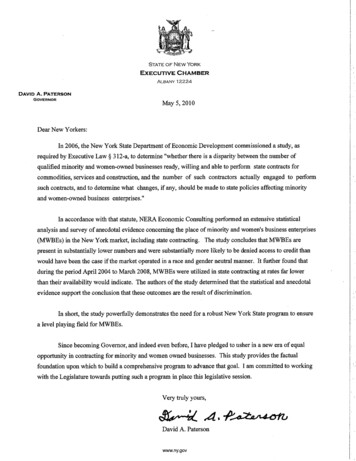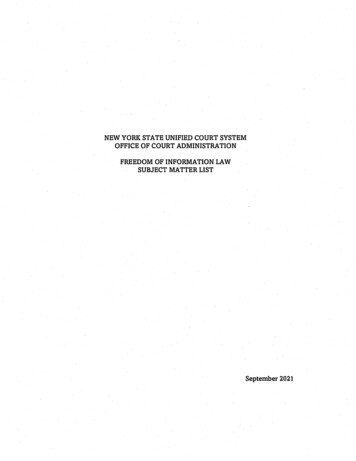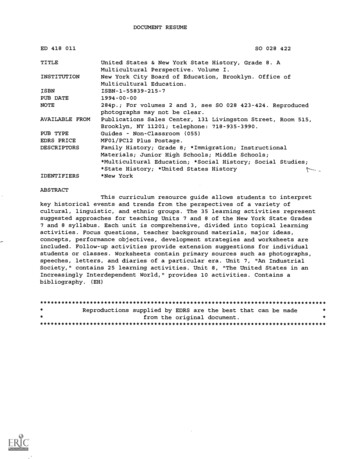
Transcription
VOLUME 1 OF 1CITY OF NEW YORK,NEW YORK COMMUNITY NAMEBRONX COUNTYKINGS COUNTYNEW YORK COUNTYCity of New YorkQUEENS COUNTYRICHMOND COUNTYPreliminary:DECEMEBER 5, 2013FLOOD INSURANCE STUDY NUMBER360497V000BVersion Number 1.0.0.0COMMUNITY NUMBER
NOTICE TOFLOOD INSURANCE STUDY USERSCommunities participating in the National Flood Insurance Program have establishedrepositories of flood hazard data for floodplain management and flood insurance purposes. ThisFlood Insurance Study (FIS) may not contain all data available within the repository. It isadvisable to contact the community repository for any additional data.Part or all of this FIS may be revised and republished at any time. In addition, part of this FISmay be revised by the Letter of Map Revision process, which does not involve republication orredistribution of the FIS. It is, therefore, the responsibility of the user to consult with communityofficials and to check the community repository to obtain the most current FIS components.Initial FIS Effective Date:Revised FIS Dates:May 16, 1983 (FIS report);November 16, 1983 (Flood Insurance Rate Map)February 15, 1991- To change zone designations and to add special floodhazard areas.May 18, 1992- To add otherwise protected areas.July 5, 1994- To add base flood elevations, to add special flood hazardareas and to change special flood hazard areas.May 21, 2001- To reflect updated topographic information, to update mapformat and to change special flood hazard areas.September 5, 2007- To reflect updated topographic information, to updatemap format and to change special flood hazard areas
TABLE OF CONTENTSPage1.0 2.0 3.0 4.0 INTRODUCTION11.1 Purpose of Study11.2 Authority and Acknowledgments11.3 Coordination2AREA STUDIED32.1 Scope of Study32.2 Community Description52.3 Principal Flood Problems82.4 Flood Protection Measures11ENGINEERING METHODS133.1 Riverine Hydrologic Analyses133.2 Riverine Hydraulic Analyses183.3 Coastal Analyses203.4 Wave Height Analyses223.5 Vertical Datum57FLOODPLAIN MANAGEMENT APPLICATIONS574.1 Floodplain Boundaries584.2 Floodways585.0 INSURANCE APPLICATIONS716.0 FLOOD INSURANCE RATE MAP727.0 OTHER STUDIES728.0 LOCATION OF DATA739.0 BIBLIOGRAPHY AND REFERENCES73
TABLE OF CONTENTS - continuedPageFIGURESFigure 1-1: Bronx published and mapping transect location map . 24 Figure 1-2: New York County published and mapping transect map . 25 Figure 1-3: Richmond County published and mapping transect map. 26 Figure 1-4: Kings County published and mapping transect map . 27 Figure 1-5: Queens County published and mapping transect map . 28 Figure 2: Transect Schematic. 31 Figure 3: Floodway Schematic . 70 TABLESTable 1 – Detailed Flooding Sources . 4Table 2 – Population And Land Area Of New York City . 6Table 3 – Summary Of Discharges . 14Table 4 – Summary Of Stillwater Elevations . 17Table 5 – Transect Data . 32 Table 6 – Floodway Data .60EXHIBITSExhibit 1 - Flood ProfilesArbutus CreekBlue Heron Main BranchBlue Heron TributaryBronx RiverButler ManorColon TributaryD Street BrookDenise TributaryEltingville TributaryForest Hill Road BrookJansen TributaryLemon CreekMill CreekMill Creek Tributary 1Mill Creek Tributary 2Mill Creek Tributary 3Richmond CreekSandy P
EXHIBITS – continuedExhibit 1 - Flood Profiles (continued)Sweet BrookWolfe’s PondPanels 42P-45PPanel 46PExhibit 2 - Flood Insurance Rate Map IndexFlood Insurance Rate Mapiii
FLOOD INSURANCE STUDYCITY OF NEW YORK,BRONX, KINGS, NEW YORK, QUEENS, AND RICHMOND COUNTIES,NEW YORK1.0INTRODUCTION1.1Purpose of StudyThis Flood Insurance Study (FIS) revises and updates a previous FIS/FloodInsurance Rate Map (FIRM) for the City of New York, which incorporates all ofBronx, Kings, New York, Queens, and Richmond counties, New York, this alsoincludes Ellis Island and Liberty Island. This information will be used by the Cityof New York to update existing floodplain regulations as part of the RegularPhase of the National Flood Insurance Program (NFIP). The information willalso be used by local and regional planners to further promote sound land use andfloodplain development.In some States or communities, floodplain management criteria or regulationsmay exist that are more restrictive or comprehensive than the minimum Federalrequirements. In such cases, the more restrictive criteria take precedence and theState (or other jurisdictional agency) will be able to explain them.1.2Authority and AcknowledgmentsThe sources of authority for this FIS are the National Flood Insurance Act of 1968and the Flood Disaster Protection Act of 1973.For the original May 16, 1983, FIS and November 16, 1983, FIRM (hereinafterreferred to as the 1983 FIS), the hydrologic and hydraulic analyses for ArthurKill, the Atlantic Ocean, Bronx Kill, the Bronx River, the East River, the HarlemRiver, the Hudson River, the Hutchinson River, Jamaica Bay, Kill Van Kull,Long Island Sound, Lower Bay, Newark Bay, Raritan Bay, and Upper Bay wereprepared by Camp, Dresser and McKee, Inc., under subcontract to the New YorkState Department of Environmental Conservation (NYSDEC) for the FederalEmergency Management Agency (FEMA), under Contract No. H-4784. Thatwork was completed in December 1981.For the February 15, 1991, revision, the hydrologic and hydraulic analyses forRanger Creek were prepared by the New York City Department of City Planningfor FEMA. That work was completed in May 1989.For the July 5, 1994, revision, the hydrologic and hydraulic analyses for SweetBrook, Colon Tributary, Eltingville Tributary, Arbutus Creek, Jansen Tributary,Denise Tributary, Lemon Creek, and Sandy Brook, were prepared by LeonardJackson Associates for FEMA, under Contract No. 91-R-3373. That work wascompleted in June 1992.1
For the May 21, 2001, revision, updated topographic information of wetlandswithin Richmond County only was prepared by the New York City Department ofEnvironmental Protection (NYCDEP). This information was agreed upon withFEMA to be used for the revision.For the September 5, 2007, revision, updated topographic information for the Cityof New York was provided by the City of New York Department of InformationTechnology and Telecommunication (DOITT) and used to redelineate all detailedflood hazard areas. Additionally, updated hydrologic and hydraulic analyses forthe Bronx River, Arbutus Creek, Blue Heron Main, Blue Heron Tributary, ButlerManor, Colon Tributary, D Street Brook, Denise Tributary, Eltingville Tributary,Foresthill Road Brook, Jansen Tributary, Lemon Creek, Mill Creek, Mill CreekTributary 1, Mill Creek Tributary 2, Mill Creek Tributary 3, Sandy Brook, SweetBrook, and Richmond Creek were prepared by Leonard Jackson Associates forFEMA, under Contract No. EMN-2003-RP-001.For the [date] revision, updated topographic information generated by LiDAR(Light Detection and Ranging) for the City of New York was collected andprocessed by Sanborn Map Company. The LiDAR data were collected fromApril 14 to May 1, 2010. The updated topographic information was used toredelineate all detailed flood hazard areas. New coastal analysis was performedfor the coastal flood hazard areas.Base map information shown on the FIRMs was provided by DOITT. Thisinformation was derived from digital orthophotography produced at a scale of1:1,200 from photography dated April 2008.The coordinate system used for the production of this FIRM is New York StatePlane FIPSZONE 3104.1.3CoordinationThe purpose of an initial Consultation Coordination Officer's (CCO) meeting is todiscuss the scope of the FIS. A final CCO meeting is held to review the results ofthe study.For the 1983 FIS, an initial CCO meeting was held on August 12, 1976, and afinal CCO meeting was held on December 13, 1982. Both of these meetings wereattended by representatives of the City of New York; Camp, Dresser and McKee,Inc.; and FEMA.For the July 5, 1994, study, an initial CCO meeting was held on February 1990and was attended by representatives of the City of New York, Leonard JacksonAssociates, and FEMA.For the May 21, 2001, revision, a Cooperating Technical Community (CTC)Agreement was made on July 8, 1999, between the Borough of Staten Island andFEMA.2
For the September 5, 2007, revision, an initial CCO meeting was held on April22, 2004, and was attended by representatives of the City of New YorkDepartment of Buildings, DOITT, City of New York Department of Planning,City of New York Office of Emergency Management, Leonard JacksonAssociates, Dewberry, and FEMA.For the [date] revision, New York City serves as a Cooperating Technical Partnerwith FEMA for this Flood Insurance Study and Flood Insurance Rate Map update.FEMA has worked closely with New York City throughout the development ofthis updated Flood Insurance Study. FEMA and NYC have met on a weekly basisto discuss technical, programmatic, and administrative matters related to thisproject. Additionally, FEMA presented detailed technical information on October18, 2012 to many NYC Departments such as New York City Department of CityPlanning, the Mayor’s Office of Long-Term Planning and Sustainability,Department of Buildings, and the Office of Emergency Management. Further, onJune 26, 2013, FEMA and the New York State Department of EnvironmentalConservation met with the New York City Department of City Planning, theMayor’s Office of Long-Term Planning and Sustainability, Department ofBuildings to discuss the regulatory aspects of administering the Flood InsuranceRate Maps and Flood Insurance Study update.2.0AREA STUDIED2.1Scope of StudyThis FIS covers the incorporated area of the City of New York, Bronx, Kings,New York, Queens, and Richmond Counties, New York; this also includes EllisIsland and Liberty Island. Although Elis Island is largely part of Jersey City, NewJersey, the island will be shown on the Hudson County, NJ maps along with theCity of New York maps.For the 1983 FIS, the following streams were studied by detailed methods: theBronx River, the Hutchinson River, the Atlantic Ocean, Raritan Bay, New YorkBay (including the Upper Bay, Lower Bay, and the Narrows), Jamaica Bay, LongIsland Sound, Little Neck Bay, the East River, the Harlem River, the HudsonRiver, Arthur Kill, Bronx Kill, and Kill Van Kull.The February 15, 1991, FIS was prepared to map wetlands as 1-percent-annualchance special flood hazard areas along Ranger Creek stream corridors inRichmond County on Staten Island.For the July 5, 1994, FIS, the following streams were studied by detailedmethods: Sweet Brook, from its confluence with the Richmond Creekswamplands to Delmar Avenue; Colon Tributary, from its confluence with SweetBrook to Gifford’s Lane; Eltingville Tributary, from its confluence with SweetBrook to the Staten Island Railroad; Arbutus Creek, from the Hylan Boulevard toa point approximately 1,200 feet upstream of Amboy Road; Jansen Tributary,from its confluence with Arbutus Creek to a point near Kingdom Avenue; DeniseTributary, from its confluence with Arbutus Creek to a point near Hogan Avenue;3
Lemon Creek, from a point approximately 500 feet upstream of Rossville Avenueto Amboy Road for a distance of approximately 1.5 miles; and Sandy Brook, fromits confluence with Lemon Creek to a point approximately 500 feet downstreamof Sharrotts Road.For the May 21, 2001, FIS, some 1-percent-annual-chance Flood (Zone A)floodplains and a portion of the 1-Percent Annual Chance Flood (Zone AE)floodplain along Eltingville Tributary, from Katan Avenue to a pointapproximately 200 feet upstream of Wilson Avenue, within Richmond County onStaten Island, were removed and/or redelineated based on updated topographicinformation (NYCDEP, 1999). The revision also incorporated the followingLetter of Map Revisions: 92-02-014P, dated December 24, 1992, to reflect theeffects of two completed storm drain projects, to contain Springville Creek in thevicinity of the Heartland Condominiums II and 98-02-698P, dated May 2, 1999,to modify Special Flood Hazard Areas (SFHAs) near the intersection of DeweyAvenue and Greaves Avenue.For the September 5, 2007 FIS, some 1-percent-annual-chance (Zone AE) and500-year (Zone X shaded) floodplains were revised and/or redelineated based onupdated topographic and base map information (NYC DOITT, 2004).The September 5, 2007 FIS also incorporates the following Letter of MapRevision: 01-02-045P, dated July 3, 2002, to reflect the construction of a rip-raprevetment and slope protection along Prince’s Bay.As part of the September 5, 2007 FIS, updated analyses were included for theflooding sources shown in Table 1, “Detailed Flooding Sources.”TABLE 1: DETAILED FLOODING SOURCESJacks PondJansen TributaryLemon CreekMill CreekMill Creek Tributary 1Mill Creek Tributary 2Mill Creek Tributary 3Richmond CreekSandy BrookStump PondSweet BrookWolfe’s PondWood Duck PondAmboy Road WetlandArbutus CreekBlue Heron MainBlue Heron TributaryBronx RiverButler ManorCleveland Avenue WetlandColon TributaryD Street BrookDenise TributaryEibs PondEltingville TributaryForest Hill Road BrookHillside Avenue WetlandLimits of detailed study are indicated on the Flood Profiles (Exhibit 1) and on theFIRM (Exhibit 2). The areas studied by detailed methods were selected withpriority given to all known flood hazard areas and areas of projected developmentand proposed construction.4
Several streams were studied by approximate methods. Approximate analyseswere used to study those areas having a low development potential or minimalflood hazards. The scope and methods of study were proposed to, and agreedupon by, FEMA and the City of New York.For the [date] FIS, new analysis for coastal flood hazard areas for the entireshoreline of the City of New York was incorporated and all detailed flood hazardareas were redelineated based on updated topographic data.2.2Community DescriptionThe City of New York is located in southeastern New York State and consists ofBronx County (Bronx Borough), Kings County (Brooklyn Borough), New YorkCounty (Manhattan Borough), Queens County (Queens Borough), and RichmondCounty (Staten Island Borough). The City of New York is bordered to the westand southwest in the State of New Jersey by Sandy Hook, the Towns ofMiddletown, Union Beach, Cliffwood, Cliffwood Beach, Lawrence Harbor,Sayreville, the City of South Amboy and the Boroughs of Keansburg and Keyportalong the southern shore of Raritan Bay; the Cities of Perth Amboy, Linden,Elizabeth and Bayonne, the Township of Woodbridge, and the Borough ofCarteret, located west of Staten Island; and the Cities of Jersey City and Hoboken,the Towns of West New York, and Guttenburg, the Townships of Weehawken,North Bergen, and Tenafly, on the west side of the Hudson River. In the State ofNew York, communities bordering the City of New York to the north include theCities of Yonkers and Mount Vernon, the Villages of Pelham Manor, Pelham, andNew Rochelle. The surface area of the City of New York is 412.3 square miles(27 percent is under water) with a land area of 303 square miles.New York City originated in the spring of 1624 when 30 families arrived onManhattan Island and constructed permanent dwellings on the southern shore,now known as the Battery. By 1700, the population had increased to 5,000. Bythat time, the docks along the coastline had been filled in with refuse and silt andpaved over so that the docks could be extended. By 1800, the population of thecity increased to 60,000. Staten Island had a population of 4,500. In 1834,Brooklyn became a city with a population of 24,000. By 1850, the population ofNew York City, still consisting only of Manhattan, had increased to 515,000. In1898, greater New York originated the merger of Manhattan with Brooklyn,Staten Island, Queens, and the Bronx. The correct borough name for RichmondCounty is also Richmond. However, the borough is most commonly referred toas Staten Island, which is used throughout this study. Today, the City of NewYork is the largest city in the United States and one of the largest cities in theworld. The 1980 population of the city was 7,035,348 (U.S. Department ofCommerce, 1981). The 1990 population of the city was 7,322,564. Thepopulation of the city increased to 8,008,278 in the 2000 Census (U.S. Census,2000). In the 2010 census, the population of the city increased to 8,175,133 (U.S.Census, 2010). The populations of the counties and boroughs in New York areshown in Table 2, “Population and Land Area of New York City.”5
TABLE 2: POPULATION AND LAND AREA OF NEW YORK CITYCountyBoroughBronxKingsNew en Island1990 CensusPopulation2000 CensusPopulation2010 CensusPopulationLand Area(sq. 82,504,7001,585,8732,230,722468,73042712310958The following brief history of the Rockaway Peninsula and Jamaica Bay willprovide some insight as to the reason data regarding the city’s coastline and waterarea should be referenced to a specific time period.In 1835, Rockaway Point was located near the present east boundary of Jacob RiisPark. East Rockaway Inlet was located 20,000 feet east of its present position,near Long Beach, New York. South of Rockaway Point, a large shoal had formedwhich was to provide the material for extending this point nearly four miles to theeast during the next 100 years. The shoreline generally receded between 1835and 1878 while, at the same time, Rockaway Point extended two miles westward.Jacob Riis Park acquired its present shoreline during this period.Between 1878 and 1927, the shoreline of the Rockaways advanced a smallamount. Rockaway Point grew rapidly until 1902, but from 1902 to 1927, itswestward expansion was only half its previous rate. From 1927 to 2007, theshoreline of the Rockaways has been stable. Nearly 12 million cubic yards ofsand have been artificially placed east of Rockaway Point since that time.Within Jamaica Bay, it has been estimated that 150 million cubic yards ofmaterial have been dredged. The most common use for dredged material has beenfor fill purposes in land reclamation projects. Originally, almost all of the areasurrounding Jamaica Bay except the barrier beach to the south was marshland.Due to extensive filling, the shoreline around the bay is always changing.Some of the larger projects in Jamaica Bay during this time were: Floyd BennetAirfield at Barren Island; the development of the Mill Basin area by privatedevelopers; the construction of Canarsie pier; the completion of the ShoreParkway over low-lying marshland; the City of New York Department of Parksreclamation work in connection with the building of Spring Creek Park; the fillaround Broad Channel and Rulers Bar Hassock for the construction of Cross BayBoulevard in the 1920s; and the operations concerned with the development ofJohn F. Kennedy Airport.The excellent harbor facilities and location in respect to canal and railroadtransportation systems have contributed to the growth of the City of New York.In addition to shoreline development associated with the city’s commerce as aport, the high population density has caused development in areas subject toflooding.6
Despite the proximity of the City of New York to the Atlantic Ocean and itsnumerous bays and rivers, the climate of the city is more continental thanmaritime. This is because the weather conditions affecting New York usuallyapproach the city from the west. However, the maritime influence is not totallyabsent. During the summer, sea breezes moderate the heat, and during the winter,coastal storms accompanied by winds from the east may bring considerableamounts of rain or snow.The mean annual temperature for the City of New York is 55.2 degreesFahrenheit (qF). Subfreezing temperatures occur on an average of 92 days peryear; however, subzero weather may occur only two days in every three winters.During an average summer, the temperature reaches the 90s on 7 days.Temperatures of 100qF or higher have occurred approximately 7 times since1871.Precipitation is moderate and is distributed evenly throughout the year. Thenormal annual precipitation is 46.2 inches; with approximately 25 inchesoccurring between April and October. A prolonged dry period may be expectedapproximately every two or three years, usually in September or October.Rainfall occurring between June and September is usually the result ofthunderstorms and is brief and relatively intense. From October through April,rainfall is generally associated with widespread storms generating day-longprecipitation. The average annual snowfall is approximately 28.6 inches andoccurs on an average of approximately 35 days between November and April.The City of New York consists of three physiographically different areas. Bronxand New York Counties are an eroded southern extension of the glaciated uplandarea that occupies a large part of New England. The northern half of Kings andQueens Counties and all but a one-mile wide strip on the southeastern shore ofRichmond County consists of terminal moraine and the hilly till-covered areanorth of the terminal moraine. The remainder of these three counties is made upof glacial outwash plain.The New York Bight is the geographic designation for the portion of thecontinental shelf bordered by the Atlantic Coastal Plain extending from CapeMay, New Jersey, northeast to Montauk, Long Island. It is characterized bybeaches, numerous shallow, irregular estuaries and bays, the most prominent ofwhich is the estuary of the Hudson River. The Hudson River has drowned valleymorphology. Sediment movement and deposition have resulted in significantchanges in the shelf area nearest the bight.Long Island Sound also has drowned valley morphology. The southern slope ofthe ground, near Long Island, is steep and smooth, reaching depths of over 140feet.New York Bay is divided into Upper New York Bay and Lower New York Bayby the Narrows. The Upper Bay is bounded by the Battery on the north and FortHamilton-Fort Wadsworth on the south. The Lower Bay is bounded by FortHamilton and Sandy Hook.7
Raritan Bay is part of the system of interconnected bays and channels surroundingStaten Island and the northern coast of New Jersey. This system also includesArthur Kill, Kill Van Kull, and Newark Bay.The Bronx River extends 23 miles from its mouth at the East River to KensicoReservoir. The Kensico Reservoir does not release flows to the river, but servesas a water supply for the City of New York. From the just downstream of thereservoir, the river flows through Westchester County. Within the City of NewYork, the Bronx River flows south from the Yonkers corporate limits through thecenter of the borough for approximately 8.7 miles to its mouth at the East River.The river once served as the border between the Cities of Yonkers and MountVernon; however, continued relocations of the river have altered this. Within theCity of New York, a series of four dams cause a drop in elevation ofapproximately 40 feet. The dams limit backwater effects from reaching farupstream on the Bronx River. Within the city, the river drops a total of 60 feetbefore flowing into the East River between Hunts Point and Claron Point. TheBronx River has a drainage area of 56.4 miles at its mouth. Exclusion of the areasdraining into four water supply reservoirs reduces the drainage area to 38.3 squaremiles. The average width of the drainage basin is 2.5 miles.The Hutchinson River originates in New Rochelle and flows for approximately 11miles to Long Island Sound. The Hutchinson River is tidally controlled for itsentire length. Within the study area, the river has a drainage area of 5.8 squaremiles. Historical discharge data for the Hutchinson River is available from USGSgaging station No. 01301500 at Pelham, New York. As of May 1, 2013 fundingwas dropped for USGS monitoring network in the five boroughs of New YorkCity. (USGS, September 24, 2013).The Hudson River originates in the Adirondack Mountains. The river has adrainage area of 13,400 square miles, most of which lie in the northern andeastern parts of New York and in small portions of Vermont, Massachusetts,Connecticut, and New Jersey. The lower Hudson is an estuary with tidal effectspropagating 150 miles upstream to the Green Island Dam at Troy, New York, anddownstream from the confluence of the Mohawk River.The East River and the Harlem River serve as a connection between the HudsonRiver, the Upper Bay and Long Island Sound.Jamaica Bay is a semi-enclosed body of water, sheltered from the Atlantic Oceanby the Rockaway Peninsula. The Rockaway Inlet is a long, narrow channelbetween the peninsula and Brooklyn, and is the only connection between the bayand the ocean during the non-storm tidal cycles. Many islands make Jamaica Bayinto a network of channels and marshy areas.2.3Principal Flood ProblemsThe City of New York is affected by flooding from local, fluvial, and coastalflooding. Local flooding refers to flooding of inland portions of the city fromshort-term, high-intensity rainfall in areas with poor drainage.8
Fluvial flooding is caused by rivers and streams overflowing their banks. Most ofthe rivers within the City of New York are tidally influenced. This means thatwater levels in the rivers are controlled by the tidal conditions at the mouth of theriver with little or no influence from the flow in the stream. Both fluvial and tidalflooding associated with waves occur within the study area; however, tidalflooding was found to be the primary cause of damage within the city.Coastal flooding is caused by long and short wave surges that affect the shores ofthe open ocean, bays and tidally influenced rivers, streams, and inlets. Themovement of coastal waters is influenced by the astronomic tide andmeteorological forces such as northeasters and hurricanes. Hurricanes andnortheasters have historically caused flooding in and around the study area.Inundation of low-lying coastal areas in the City of New York is primarily theresult of storm surges, wave setup, and wave runup, which occur duringhurricanes and northeasters.The City of New York is built in a confined coastal location, which accounts formuch of its natural protection against hurricanes. The strongest winds from astorm rarely reach New York since the New Jersey coast is on one side of the cityand Long Island is on the other side. However, high storm surges can propagatewithin the New York Bight and cause severe flooding along the coastal portionsof the city. Moreover, the cuplike topography of the area accounts for most of thedynamic effects, including resurgence, which cause the waters to oscillate to floodlevels well after the storm has left the area.Sections of Queens, Brooklyn, and Staten Island are exposed to direct oceansurges and waves. Coney Island and the Rockaway Peninsula are particularlyvulnerable to wave damage. On Rockaway Peninsula and Jamaica Bay, theshoreline configuration has changed considerably over the past 50 years due todredging and filling. These changes affect wave propagation, particularly in areassuch as Rockaway Point at Rockaway Inlet, where the configuration of the pointcontrols the direction of the incoming waves. Surge waves can also propagatethrough Long Island Sound. Consequently, a surge wave can propagate in theNew York Bight, move into New York Bay through the Hudson River and enterthe East River from the south.Jamaica Bay is affected by astronomical tides, storm surges from the AtlanticOcean off New York Bay, wind-generated wave setups within the bay, andrainfall runoff from other areas (American Society of Engineering, 1964). Theouter shoreline of the Rockaway Peninsula is subject to tidal fluctuations from theAtlantic Ocean. The Rockaway Peninsula can be a surge barriers to Jamaica Bayduring small storm surges; however, a storm surge can almost entirely overtopand inundate the peninsula during larger surge events.The most severe flooding conditions result from the overtopping of the peninsula.The low-lying areas of Brooklyn and Southern Queens including Kennedy Airportare directly affected by flooding from Jamaica Bay.9
The northern portion of Queens and the east Bronx are directly affected by surgesoriginating in Long Island Sound. The east shore of City Island has a history ofsevere damage. In 1969, it was estimated that a recurrence of the 1938 hurricane,the storm of record, would produce 23 million damage of City Island alone.Detailed descriptions of coastal flood damage in and around the City of NewYork caused by the November 1950, November 1953, September 1960, andMarch 1962 storms are presented in Study Overview (Camp, Dresser and McKee,1983).The storm of November 1950 caused millions of dollars worth of damage andrequired evacuation of many parts of New York. Damage as a result of the floo
FLOOD INSURANCE STUDY NUMBER 360497V000B Version Number 1.0.0.0 City of New York . NOTICE TO . Forest Hill Road Brook Panels 17P-19P Jansen Tributary Panel 20P . Island Sound, Little Neck Bay, the East River, the Harlem River, the Hudson River, Arthur Kill, Bronx Kill, and Kill Van Kull.


